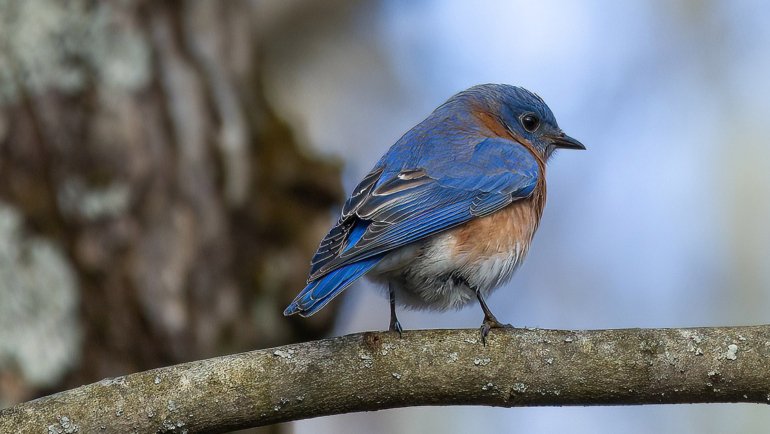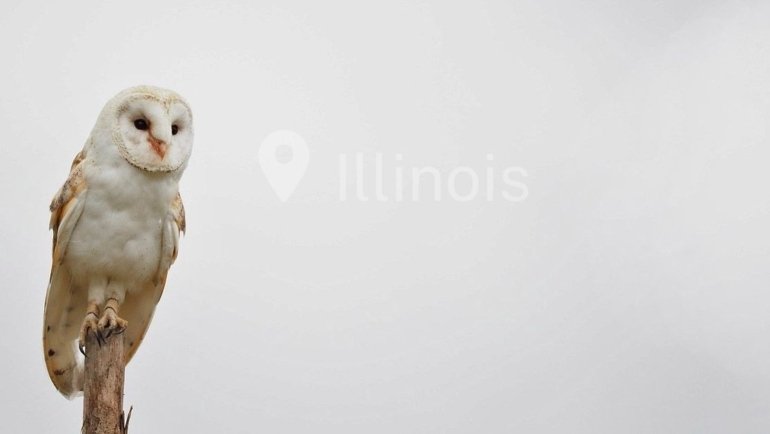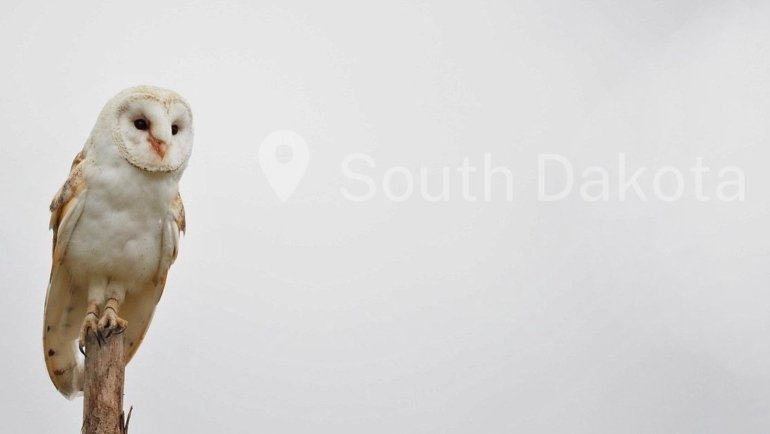Indiana, the Hoosier State, is a land teeming with wildlife. Nestled in the Great Lakes region, the state boasts a diverse variety of landscapes, from vast farmlands to dense forests and rolling hills. This rich biodiversity makes it an excellent home for an array of bird species, including the mysterious and captivating owls.
This article will introduce you to the eight owl species that call Indiana their home, where to spot them, and some fascinating facts about these nocturnal birds of prey.
Owl Species Found in Indiana
Great Horned Owl

- Scientific name: Bubo virginianus
- Size: 46-63 cm (18.1-24.8 inches)
- Weight: 910-2,500 grams (2-5.5 pounds)
- Wingspan: 91-153 cm (36-60.2 inches)
- Time of the year: Year-round
The Great Horned Owl, a native resident of Indiana, is the heaviest owl in North America. Adorned with tufts of feathers that resemble horns and striking yellow eyes, this raptor is truly magnificent. It can be found year-round across the state, favoring woodlands, swamps, and agricultural areas.
These owls are highly adaptable and can hunt a wide variety of prey, from rodents and rabbits to other birds and even reptiles. They have an incredible gripping strength which, combined with their sharp talons, allows them to catch and kill prey much larger than themselves.
Did you know? The Great Horned Owl is often referred to as the “tiger of the skies” due to its aggressive nature and hunting prowess.
Eastern Screech Owl
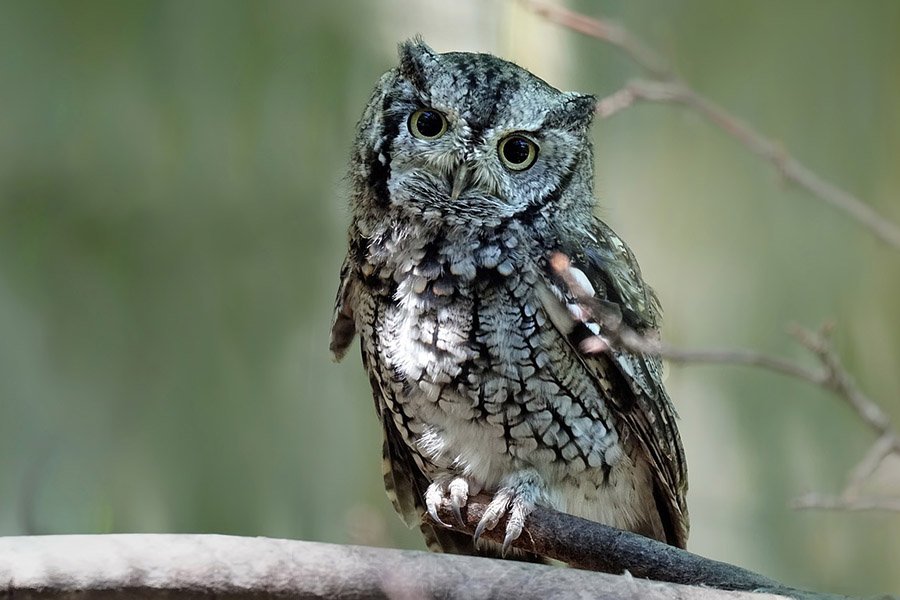
- Scientific name: Megascops asio
- Size: 16-25 cm (6.3-9.8 inches)
- Weight: 121-244 grams (4.3-8.6 ounces)
- Wingspan: 46-61 cm (18.1-24 inches)
- Time of the year: Year-round
The Eastern Screech Owl is one of the smallest owl species in Indiana and can be spotted year-round. Despite its small size, it has a large presence, filling the night with its haunting trills and whinnies. These owls are highly adaptable and can be found in a variety of habitats, including woodlands, suburbs, and parks.
Eastern Screech Owls have excellent camouflage, with coloration that helps them blend in with tree bark. Their diet consists mainly of insects, small birds, and rodents, which they catch with their sharp talons during the night.
Did you know? Eastern Screech Owls come in two color morphs, red and gray, providing them excellent camouflage against tree bark. The color of the owl does not indicate its age or gender.
Barred Owl

- Scientific name: Strix varia
- Size: 40-63 cm (16-25 inches)
- Weight: 500-1,050 grams (1.1-2.3 pounds)
- Wingspan: 96-125 cm (38-49 inches)
- Time of the year: Year-round
The Barred Owl, also known as the hoot owl for its distinctive call, is a resident of Indiana’s mature forests, particularly those near water bodies. Known for their striking black eyes, they sport a pattern of bars and streaks on their plumage, giving them their name.
Barred Owls are hunters that prefer the cover of night. Their diet primarily consists of small mammals, but they also hunt birds, amphibians, and invertebrates. They are known for their hooting call that sounds like “Who cooks for you? Who cooks for you all?”
Did you know? Unlike most owl species, Barred Owls have dark eyes instead of the typical yellow. This characteristic helps birdwatchers identify them, even from a distance.
Northern Saw-Whet Owl
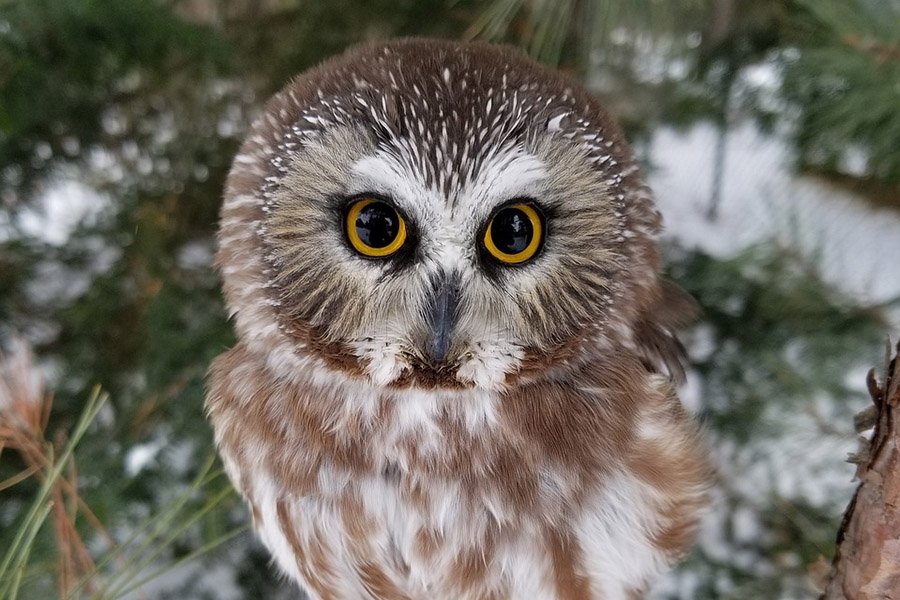
- Scientific name: Aegolius acadicus
- Size: 17-22 cm (6.7-8.7 inches)
- Weight: 54-151 grams (1.9-5.3 ounces)
- Wingspan: 42-56.3 cm (16.5-22.2 inches)
- Time of the year: Winter
The Northern Saw-whet Owl, one of the smallest owl species in North America, is a winter visitor to Indiana. Named for its call, which resembles the sound of a saw being sharpened, this tiny owl prefers dense forests with thick underbrush.
The Northern Saw-whet Owl is a formidable hunter despite its small size, catching mice and other small rodents, and sometimes small birds. They have a unique hunting style, often perching and waiting for prey to come within striking distance before launching a swift, silent attack.
Did you know? Northern Saw-whet Owls got their name because their call reminded some people of the sound of a whetstone sharpening a saw.
Barn Owl
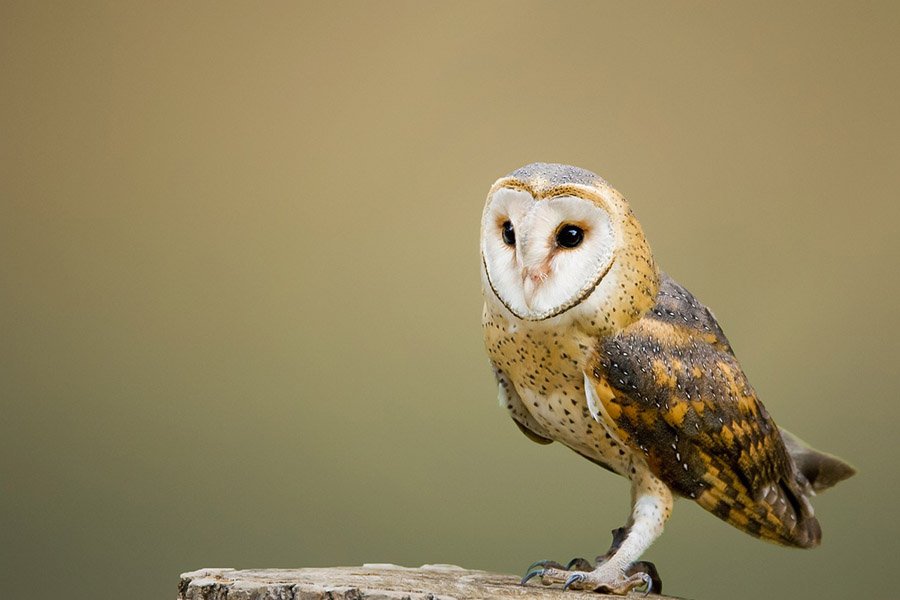
- Scientific name: Tyto alba
- Size: 33-39 cm (13-15.5 inches)
- Weight: 224-710 grams (7.9-25.0 ounces)
- Wingspan: 80-95 cm (31.5-37.4 inches)
- Time of the year: Year-round
Barn Owls, with their distinctive heart-shaped faces and haunting screeches, can be found year-round in Indiana. They prefer open habitats like farmland, grassland, and marshes, often nesting in barns, old buildings, or specially-designed nest boxes.
These owls are excellent rodent hunters, with a single Barn Owl consuming about 1,000 mice each year. They hunt by flying low over open fields at night, using their keen hearing to locate their prey.
Did you know? Barn Owls do not hoot like many owl species. Instead, they emit a long, eerie screech, which has earned them nicknames such as “ghost owl” or “demon owl”.
Long-Eared Owl
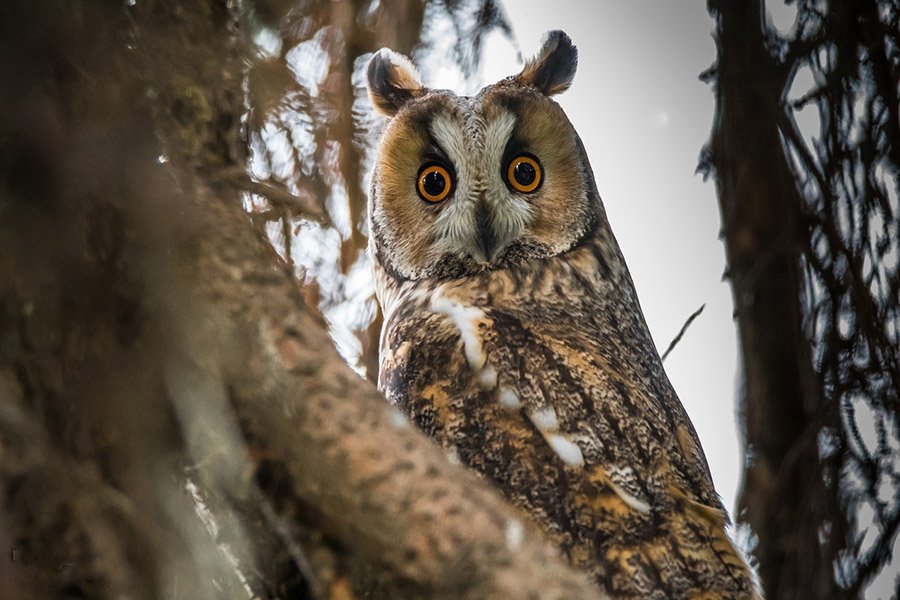
- Scientific name: Asio otus
- Size: 31-40 cm (12-16 inches)
- Weight: 178-435 grams (6.3-15.3 ounces)
- Wingspan: 90-100 cm (35.4-39.4 inches)
- Time of the year: Winter
The Long-eared Owl, named for its distinctive feather tufts that look like ears, is a winter visitor to Indiana. These secretive owls prefer dense forests for roosting during the day and open fields for hunting at night.
Long-eared Owls primarily feed on small mammals, particularly rodents, and occasionally birds. They have an interesting roosting behavior, often forming communal winter roosts with several owls perched together in the same tree.
Did you know? The “ears” of Long-eared Owls are actually feather tufts on their heads. Their real ears are hidden on the sides of their heads, and their asymmetrical placement helps the owl pinpoint the location of sounds in the dark.
Short-Eared Owl
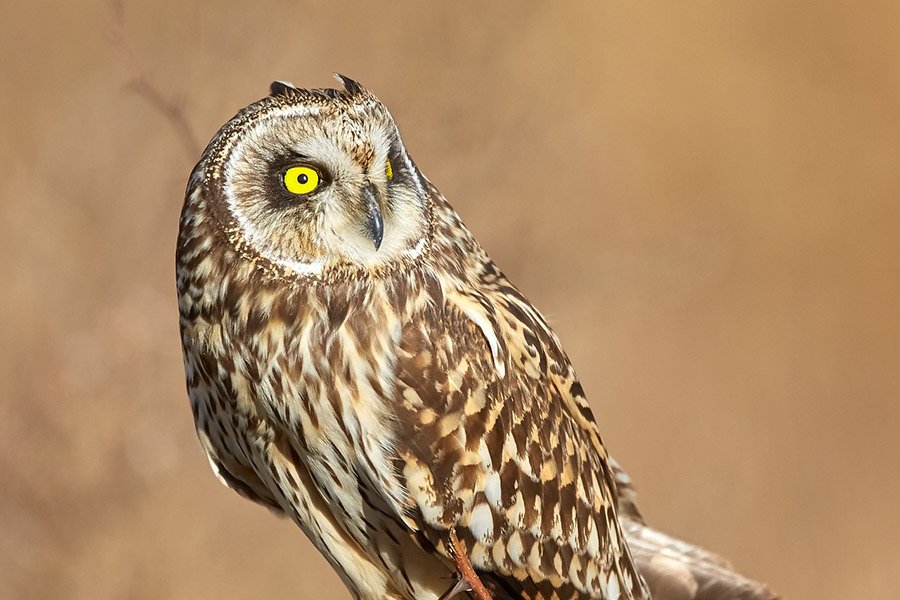
- Scientific name: Asio flammeus
- Size: 34-43 cm (13.4-16.9 inches)
- Weight: 206-475 grams (7.3-16.8 ounces)
- Wingspan: 85-110 cm (33.5-43.3 inches)
- Time of the year: Winter
The Short-Eared Owl is a winter visitor in Indiana, primarily spotted in open landscapes like grasslands and marshes. As the name suggests, these owls have short ear tufts that are often difficult to see, making their bright yellow eyes stand out against their brown and white mottled plumage.
These owls have a hunting strategy similar to that of Northern Harriers, flying low over fields and marshes, using their keen sense of hearing to locate small mammals hidden in the vegetation. They are primarily crepuscular, being most active at dawn and dusk.
Did you know? Short-Eared Owls are one of the most widely distributed owls in the world, found on all continents except Antarctica and Australia.
Snowy Owl
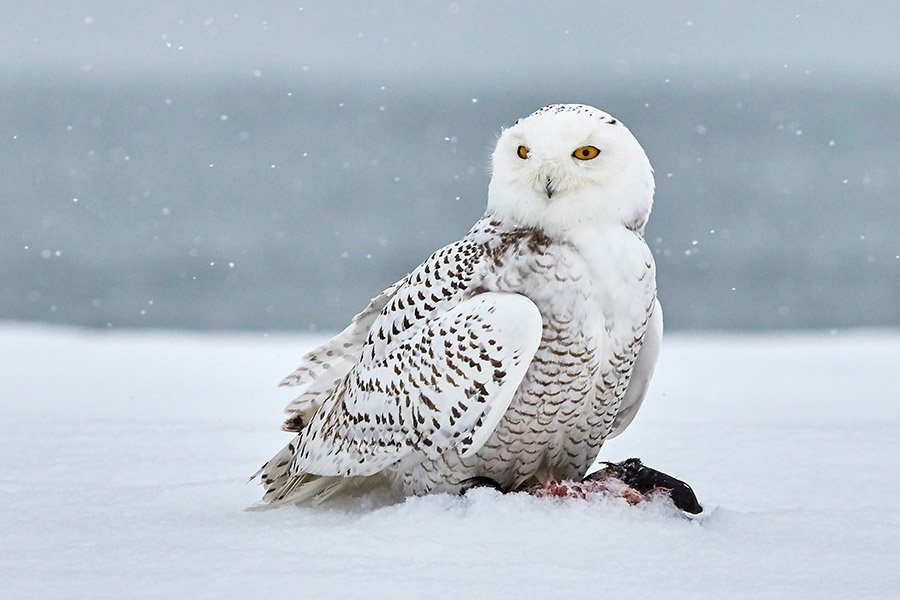
- Scientific name: Bubo scandiacus
- Size: 52-71 cm (20.5-28 inches)
- Weight: 1,600-2,700 grams (3.5-6 pounds)
- Wingspan: 125-150 cm (49.2-59.1 inches)
- Time of the year: Winter
The Snowy Owl, instantly recognizable due to its stunning white plumage, is a rare winter visitor in Indiana. These owls prefer open landscapes, mimicking their arctic tundra habitat, and can often be seen perched on the ground or low posts.
These majestic birds are known for their impressive hunting skills, feeding primarily on lemmings in their native arctic habitat, but will also catch other small mammals and birds. They are diurnal, more active during the day compared to most owls.
Did you know? The Snowy Owl was made famous in the Harry Potter series, where a Snowy Owl named Hedwig was the loyal companion of the title character.
Where & How to Observe Owls in Indiana
Indiana’s diverse ecosystems make it a great state for owl spotting. From the large Great Horned Owls to the tiny Northern Saw-whet Owls, each species has a favorite haunt. Here are a few places and tips for the prospective owl watcher:
- Fort Harrison State Park: Located in Lawrence, this state park is a known haven for the Barred Owl.
- Indiana Dunes National Park: This park is a migratory bird hotspot, and you might get lucky and spot a variety of owl species.
- Hoosier National Forest: In this expansive forest, you stand a chance to spot Great Horned Owls, Eastern Screech Owls, and more.
- Eagle Creek Park: Located in Indianapolis, this park is a great place to spot a variety of owls, especially during winter months.
Owls in Indiana are found in a variety of habitats – from the dense, mature forests favored by the Barred and Great Horned Owls, to the open grasslands and marshes where you might spot Short-Eared Owls.
Quick Tips For Owl Spotting
- Be Patient: Owls are secretive and well-camouflaged. It might take some time before you spot one.
- Be Quiet: Noise can disturb owls and make them less likely to show themselves.
- Look at Night or Dusk/Dawn: Many owls are most active during these times. However, remember to respect park hours and local regulations.
- Listen for Calls: Often, you’ll hear an owl before you see it. Learn the calls of different species to help identify them.
- Look for Signs: Look for pellets under trees, whitewash (droppings) on the tree or ground, or plucked feathers from their prey, which can all be signs of an owl’s presence.
- Use Optics: A good pair of binoculars or a spotting scope can greatly aid in your search.
- Don’t Disturb: If you do find an owl, keep a respectful distance to avoid disturbing it.
Remember, the goal is to enjoy nature and observe owls without causing them any distress. Happy owl-watching in Indiana!
Owls in Other States
- Alabama
- Alaska
- Arizona
- Arkansas
- California
- Colorado
- Connecticut
- Delaware
- Florida
- Georgia
- Hawaii
- Idaho
- Illinois
- Indiana
- Iowa
- Kansas
- Kentucky
- Louisiana
- Maine
- Maryland
- Massachusetts
- Michigan
- Minnesota
- Mississippi
- Missouri
- Montana
- Nebraska
- Nevada
- New Hampshire
- New Jersey
- New Mexico
- New York
- North Carolina
- North Dakota
- Ohio
- Oklahoma
- Oregon
- Pennsylvania
- Rhode Island
- South Carolina
- South Dakota
- Tennessee
- Texas
- Utah
- Vermont
- Virginia
- Washington
- West Virginia
- Wisconsin
- Wyoming

